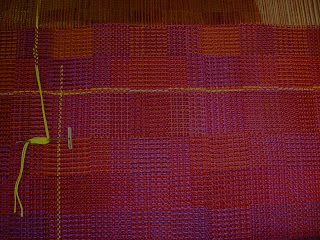Yesterday I started talking about some of the specifics of my next crackle project, specifically the treadling. I gave the (corrected) threading I planned to use but I also explained some things about the kind of threading I am using. This is a threading that allows you to have 8 crackle blocks on 4 shafts.
Now I have been starting to work out some treadlings. Here is the first treadling, and it is the first treadling that Zielinski discusses as well. The threading I have used here, by the way, is not the threading for my next project, but the simplified threading where each block as only one unit. Zielinski calls it a simple ascending diagonal. The only difference between this threading, however, and the threading that I am using in my project is that in my threading, each unit is repeated three times. So mine, too, will be a simple ascending diagonal, just a bit longer.
Here are the threading, the tie-up, the treadling, and the draw down:

Look at the treadling. If you look at the first treadle, then the 3rd, 5th and ensuing odd treadles, you will see what are called the pattern treadles. These are the treadling as drawn-in treadles.
The first treadle raises shafts 1 and 4 and the third treadle raises shafts 2 and 4. If you then look at the threading, the threading for the first unit is 1,4,2,4. These are the shafts that the first two pattern treadles are raising.
Looking at the next set of pattern treadles (5 and 7), treadle 5 raises shafts 2 and 4 and treadle 7 raises shafts 1 and 2. The threading for the second crackle unit is 4,2,1,2. These are the shafts that the second set of pattern treadles are raising. Note, by the way, that the incidental thread between these two units (the 5th thread, on shaft 1) is not counted in figuring the the pattern treadles.
The remaining six threading units and their treadling follows the same procedure.
But there is a problem. Treadling these pattern treadles creates floats more than 3 threads long. The answer to that, of course, is to treadle the tabbies in between the pattern wefts. This is always the solution in crackle structure. If you look at the tie-up, there they are, treadles 1 and 3 and treadles 2 and 4.
But, there is a catch. These treadles do not raise tabby sheds. Raising treadles 1 and 3 does not raise each and every alternate warp end. Nor does raising treadles 2 and 4. How, then, do we create a binder weft?
The binder weft is created like this. Each time a pattern weft is treadled, the treadle that raises the shafts opposite to the pattern weft shafts is raised. Thus, when shafts 1 and 4 are raised for the first pattern treadle, then the next shafts which are raised are shafts 2 and 3.
Looking at the next pattern treadle: here the pattern treadle is the treadle which raises shafts 2 and 4. This is then followed by the binder treadle which raises shafts 1 and 3.
And this pattern follows through the remaining treadling. Pattern treadle, then binder treadle which raises the opposite shafts.
Here is a simulation of what the fabric would look like. I call it a simulation because I have reduced the size of the drawdown to the point where it looks more like what the fabric would really look like when woven.

Here the areas of floats are more clearly set off from the areas without the floats. The blocks are a bit easier to see here. It is also easier to see that the blocks here are a bit more muddied than they are in ordinary 4-shaft crackle. That, however, is not necessarily an issue for me. In fact, it might possibly enhance my attempts to manipulate color. But only actual weaving will show me how true, if true at all, that is.

Here, to the right, is the same threading, also treadled as drawn in, but without the binding treadles. I did this because I wanted to get an idea of what the fabric would look like if I used a fine thread for the binder threads and a thick thread for the pattern threads. Weaving in this way makes the binder threads practically invisible, so presenting the draw down in this fashion is actually more realistic than just making the pattern threads twice as as long in the draw down.
Eliminating these binder threads, however, has also highlighted something interesting. There are times that the first pattern treadle from one unit is the same pattern treadle from the preceding unit. That this is going to happen actually follows from the threading.
My next step will be to try reversing these orders so that I no longer get two of the same pattern treadles in a row. As long as I keep the two pattern treadles for each unit together, it would not seem to make a difference which order I place them. Then I will see what happens when I put the binding treadles back in.
One thing that is illuminating here is the value of weaving software. It has the ability to bring into focus things that need to be attended to before I actually start the weaving itself.





































